Reliability Analysis of Multisensor Fusion Technology in Disaster Nursing Application
Abstract
The harm and impact of various natural disasters are becoming more and more obvious. Due to the high suddenness of natural disasters and the low efficiency of information sharing, our stress system will still not be able to respond to disasters in time. Therefore, facing the current complex natural environment and the diversity of disasters, we urgently need a practical and comprehensive online collaborative natural disaster protection system. Therefore, this paper proposes a disaster protection application system based on a multisensor information fusion algorithm. Firstly, the software platform of the natural disaster protection system based on multisensor is constructed; the hardware platform of multisensor disaster acquisition is designed. An information fusion algorithm based on Kalman joint filter is proposed. The main problems of joint filter are (1) improving the filtering accuracy, (2) improving the fault-tolerant performance of the filter, and (3) optimizing the fusion algorithm and reducing the amount of calculation and data communication, so as to facilitate real-time implementation of the algorithm. Combined with DS evidence theory, BP neural network, and support vector mechanism, a comprehensive diagnosis model is established. The model uses the preliminary diagnosis results of the BP neural network and support vector machine to carry out the BPA of DS evidence theory, which avoids the blindness caused by human operation. The simulation results show that the comprehensive diagnosis model can significantly improve the prediction accuracy of disasters, solve the uncertainty and fuzziness of diagnosis results of a single diagnosis model, and provide a new method for disaster protection. The results of the BP neural network in the disaster nursing system are fused at the decision level, the results show that the distribution probability corresponding to the fusion disaster category is greater than the threshold value of 0.8, and the diagnosis result can be given immediately. The diagnosis result is completely consistent with the actual disaster category.
1. Introduction
A geological disaster refers to a geological phenomenon caused by a change in the external environment or human interference. It is often in constant change, and it is always in an active state. Therefore, it is undoubtedly difficult to make decisions on geological disaster prevention information, because its variability often leads to a large number of data interference in the decision-making process [1]. At present, the conventional geological disaster prevention and decision-making system is based on GIS technology; according to this technology, the area of geological disaster is located, and relevant information is input, so as to carry out geological disaster prevention information and decision-making processing [2]. In short, the system can be based on information processing, use relevant technologies to locate spatial information, collect information data, store, and transmit it, so as to generate early warning [3, 4]. The function of the information module in the system is to collect and manage data, provide different query methods to meet the needs of different departments and users, and provide decision support for governments at all levels and relevant departments. The network program in the system can be used as the basic guarantee for geological disaster prevention and transmission, disaster information disclosure, real-time information processing, and other issues [5]. Some scholars have tested the computer research of geological disaster prevention and decision support, which has laid the corresponding foundation for the research of this paper. The application fields of information fusion are also expanding and gradually infiltrating from the military field to other fields, such as intelligent robot and intelligent vehicle field, medical image processing and diagnosis, weather forecast, earth science, agricultural application field, modern manufacturing field, and economic and commercial field. In addition, information fusion is also used for train positioning, fish identification, or vehicle passing detection.
The term “information fusion” first came from the United States. The concept or term of information integration began to appear in some publicly published documents. For a long period of time thereafter, the term “information fusion” was widely used [3]. Considering the diversity of information, the term “information fusion” was widely used according to the meaning of information and data. Information fusion technology is a signal processing process [6]. Its final goal is to improve the effectiveness, stability, and robustness of the whole sensor system by using the advantages of joint multiple sensors [7, 8]. The main function of multiple sensors is to obtain relatively more perfect information, which can provide a more powerful basis for analysis, research, and decision-making, thus forming a large amount of data. The fusion algorithm has become the key to making it play a role [9]. Choosing a more intelligent fusion algorithm that conforms to the actual situation is the key to the success of information fusion [10]. The information monitored by multisensor contains comprehensive information, which is characterized by multisource and complexity. Relatively, these characteristics require that the information fusion method must have strong robustness and stable parallel processing ability [11]. Another classification standard is to divide into the signal level, evidence level, and dynamic level according to sensor integration and data fusion. The fusion processing object is mainly for the original data of the sensor and the information generated in each stage of preprocessing [12]. In this process, it is mainly to maintain the characteristics of the original information as much as possible. The purpose of fusion different from the other two levels is to provide more subtle information. Its limitations are mainly due to the costs of various aspects caused by a large amount of data, such as large traffic and high processing costs, as well as the picky requirements for the stability of the sensor and pixel accuracy. Feature level information fusion uses the feature information extracted from the original data of each sensor to carry out the intermediate level process of comprehensive analysis and processing. Feature level information fusion is generally used to provide a decision-making basis for decision-making level information fusion, so the purpose of feature level information fusion generally includes the classification, collection, and synthesis of monitoring information. The amount of information extracted is the full representation or statistics of data information; it is subdivided into target state information fusion and target characteristic information fusion. Decision level information fusion is the highest level fusion processing of information fusion. The monitoring data gets a preliminary simple judgment after data preprocessing, feature extraction, and recognition [13]. Finally, it is processed by decision information fusion. The intelligent fusion method is used to make decision fusion judgment to obtain the joint inference results and then provide a strong basis for the final decision. Therefore, feature level information fusion is the basis of decision level information fusion [13].
Information fusion is the main means of information acquisition, processing, and synthesis of multisensor systems and the key core technology of intelligent information processing systems. Its basic task is to synthesize the information flow from different sensors to form a higher characteristic intelligent model of monitoring and control environment. Its research level directly determines the performance of the information integration system. In other words, whether the multisensor system can effectively integrate the multidimensional information provided depends on the information fusion structure and algorithm. In the study of flood disaster early warning model, literature [14] proposed an early warning model and evaluation method based on the time dimension by analyzing the damage to power facilities in flood disasters. In the study of landslide disaster, literature [15] judged the correlation between landslide and rainfall according to the occurrence scale and frequency of landslide disaster. Literature [16] used a multiple regression model to conduct regression analysis on landslide mass and described the horizontal motion law of landslide mass from a statistical point of view. In the study of power grid vulnerability, aiming at the instability of the power system, literature [17] constructs the probability model of transmission line failure. Literature [18] proposes a method to test the cable stiffness. Through comparative analysis, this method is more effective for the discrete model. However, the research on disaster prediction using target recognition technology in multisensor data fusion technology is still in its infancy, and I hope to make development and breakthrough through my own efforts. The D-S (Dempster Shafer) evidence theory algorithm has a strong ability to process uncertain information. It does not need prior information, and it does not need to accurately understand the relationship between various sensor data. The method of “interval estimation” rather than “point estimation” is used to describe uncertain information. It shows great flexibility in distinguishing unknown and uncertain information and accurately reflecting evidence collection; the disaster accident in the disaster system itself is affected by many factors. If only one factor is considered, it will often lead to misjudgment of the underground state and serious consequences. Moreover, the correlation between various sensors in the disaster system is relatively small, which just conforms to the application scope of D-S evidence theory.
The main contributions of this paper are summarized as follows: (a) the software platform of natural disaster protection system based on multisensor is constructed. The hardware platform of multisensor disaster acquisition is designed. (b) An information fusion algorithm based on Kalman joint filter is proposed. (c) Reduce the amount of calculation and data communication, and facilitate the real-time implementation of the algorithm. Combined with DS evidence theory, BP neural network, and support vector machine, a comprehensive diagnosis model is established.
2. Design of the Disaster Nursing System
2.1. Overall Framework Design of Disaster Nursing System
The system mainly includes an information acquisition module, transmission module, decision support module, and visualization module. The overall framework design of the disaster nursing system is designed as shown in Figure 1.
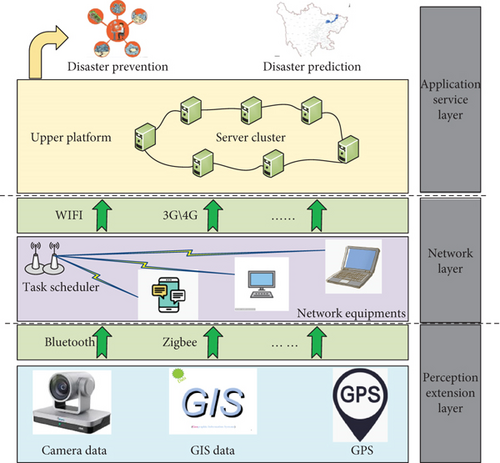
As is shown in Figure 1, (a) collect the prevention information of geological disasters. The main function of the data information management program is the collection of geological disaster prevention information. It can also input, store, manage, query, display, and update all kinds of geological disaster prevention information. In terms of function, it can be managed through an information set, so as to realize data entry and editing, system library editing, etc. The information set is composed of six submodules, which browse and search together to achieve data output. The information set realizes the data information structure management represented by the directory tree window, which is the core of the information data management of the whole subprogram. Through the construction of the data source directory tree to reflect the data information and its correlation, the multilayer structure is used to realize the collection of geological disaster prevention information. (b) Build the development environment of the decision support platform. The overall goal of this system design should meet the auxiliary management of “normal emergency management” and “combat structure analysis” of geological disasters for analysis and decision-making. In addition, in the linkage analysis function of national transition from normal emergency and the emergency management and decision-making analysis of geological disaster rescue, the emergency plan, emergency inspection, planning and training, emergency coordination, emergency management document preparation, etc., must be completed in advance and meet the information processing and analysis functions required for this, as the decision-making measures of the platform. Make full use of the risk source monitoring data and emergency patrol information of geological disasters, analyze, evaluate and predict according to the established model, and give early warning of abnormal conditions and risk levels. Once problems occur, it is necessary to formulate reasonable solutions according to the emergency plan and take preventive measures immediately in combination with the dynamic changes of geological disasters. (c) Establish the database of the decision support platform. To build the database of the whole decision support system, we should start from the specific data of geological disaster prevention information, select the area where the data is located, establish a general platform for data management, input the information of the platform into the database program, and build it in groups, so as to divide different types of information into different categories for subsequent processing. (d) Visualize geological disaster prevention decision-making information. GML is organized and developed by OGC, which can realize the output of decision information of the whole decision support platform. When it is used, it needs to exchange data in advance to transform spatial information. In addition, it does not pay attention to the visualization function and can directly realize the output and visualization of decision information.
In addition, the main goal of the development of this system is to realize a national music classification system, which can provide batch opera classification and annotation services for any user who has the need for national music sorting and classification. This system selects the Mel-cepstrum coefficient that reflects the timbre and the pitch frequency, formant, and band energy distribution that reflect the melody. Combined with the deep confidence network model, it trains a large number of labeled samples to obtain the ability to classify national music and saves the classification model that meets the classification requirements through the test set to the system, so as to achieve the classification goal of unknown style national music.
2.2. Analysis and Design of System Hardware Architecture
This paper describes a measurement system for data fusion processing, so the system requirement analysis considered is relatively comprehensive and complete. It not only involves the hardware platform requirements of data fusion but also needs to match the specific requirements of the industrial site and expand the necessary communication interfaces. To sum up, the demand analysis of system design is as follows.
(1) It is necessary to implement the part based on a multisensor data fusion algorithm and complete the model establishment process of the Dempster Shafer fusion algorithm, that is, the whole process of data fusion processing. (2) It needs an input channel for external sensors to collect data, so as to obtain the industrial field measurement data in real time and accurately, and then hand it over to the algorithm processing module for calculation and processing. (3) A certain operation interface is required for input of external operation, manual parameter setting of algorithm, start and stop of system, switch and adjustment of each function module, query of calculation result information, etc. (4) A certain display interface is required to display the current operation settings and parameter settings and provide a complete human-machine interface in Chinese, which is convenient for users to operate and set. (5) Various communication interfaces are required to ensure the universality and platform of the measurement platform and facilitate the interconnection with other control and detection equipment, including the network interface, serial communication interface, USB interface, and various bus interfaces.
Considering the design requirements of the measurement platform studied in this paper, modular design is the most suitable implementation method. The hardware structure diagram is shown in Figure 2. That is, the whole hardware platform is divided into four submodules according to different design requirements. Each module completes certain system functions, and at the same time, good communication and connection between modules are maintained. According to this idea, the hardware platform of the system is mainly composed of four modules: core board, sensor board, I/O interface board, and man-machine interface board. As is shown, the core of the soft measurement platform described in this paper is a dual-core processor chip OMAP-l137 of TI Company, as shown in Figure 2. It is a processor launched by TI Company that can be used for industrial control, network communication, high-speed coding, and professional audio processing, so it is very suitable for the application environment of soft measurement. The 300 MHz ARM processor is mainly responsible for the process scheduling of the whole algorithm and the control functions of various signals on the industrial site. If the operating system is transplanted, it can also realize the functions of file management, process scheduling, memory management, etc., while the 300 VII 4Z DSP floating-point processor is mainly responsible for the processing of digital signals and high-precision floating-point operations, which effectively makes up for the shortage of the ARM926EJ-S processor in the calculation accuracy.
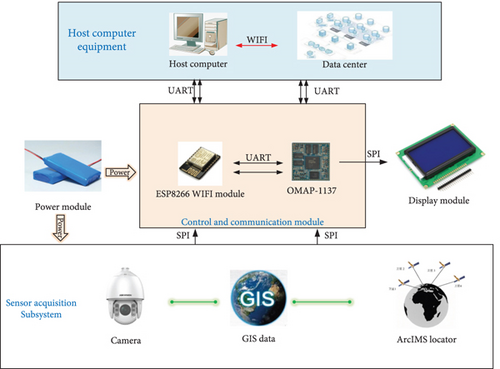
3. Research on Disaster Nursing Based on Multisensor Fusion Technology
According to the characteristics of natural disasters, the algorithm framework diagram shown in Figure 3 is designed. Firstly, the camera, GIS, and GPS data are preprocessed, and multisensor information fusion is carried out. Then, the fused data are used to make disaster warning and protection through the BP neural network and D-S evidence theory and finally visualized through the platform.
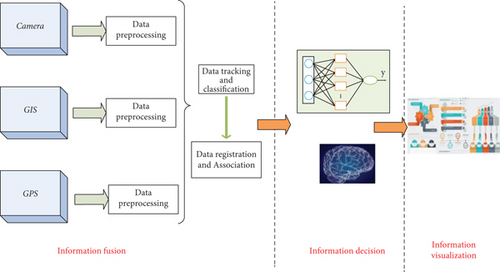
3.1. Multisensor Information Fusion Technology
For information fusion, the information representation and processing methods used come from these fields. From the functional model of information fusion, we can see that the basic functions of fusion are correlation, estimation, and recognition, with emphasis on estimation and recognition.
Therefore, the design of the fusion algorithm based on joint Kalman filter is the core content of information fusion technology. Remember that the state estimation vector, system covariance matrix, and state vector covariance matrix of local filter I are , Q1, Pi. The global filter is , Qm, Pm. Then, the calculation structure of the joint filter is shown in Figure 4.
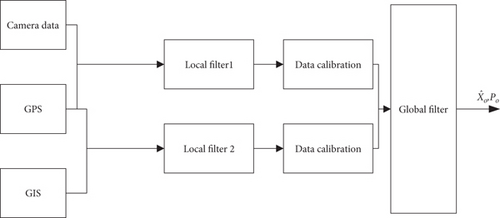
3.2. Research on Disaster Nursing Prediction Algorithm Based on DSBP
Although the BP network has been widely used, it also has some defects and shortcomings, mainly including several aspects: (1) Because the learning speed is fixed, the convergence speed of the network is slow and it takes a long time to train. For some complex problems, the training time of the BP algorithm may be very long. This is mainly because the learning rate is too small and can be improved by changing the learning rate or adaptive learning rate [19]. (2) The BP algorithm can make the weight converge to a certain value, but it cannot guarantee that it is the global minimum of the error plane. This is because the gradient descent method may produce a local minimum. The additional momentum method can be used to solve this problem [20].
Firstly, the characteristic parameters of fire are detected by the fire detection sensor group, and then, the measured data are normalized and processed as the input parameters of BP. These parameters are then processed by the BP neural network and output. The range of output results is between [0, 1]. These output results are the input of DS evidence theory. At this time, the results have certain reliability and accuracy after the initial fusion of neural networks. Then, the data are fused again by using DS evidence theory to obtain the unique probability distribution function. Finally, the judgment result of whether the fire occurs is obtained according to the judgment rules. The specific algorithm structure is shown in Figure 5.
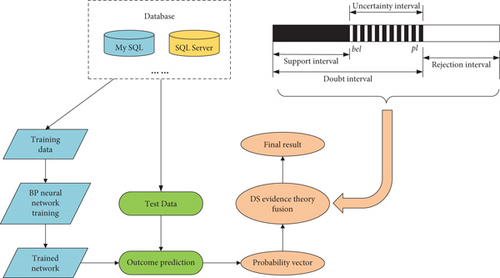
Decision level fusion is based on the independent decision-making or classification of the information collected by each local sensor after preprocessing, feature extraction, and recognition, and then, the fusion system transmits the preliminary decision-making information to the decision center for comprehensive evaluation with the help of certain criteria and algorithms, so as to make a globally optimal decision [21]. The data processing of decision level fusion is concentrated in the fusion center, which has strong system stability and fault tolerance, and will not greatly affect the performance of the fusion system due to the effectiveness of several sensors. At the same time, due to the small amount of data, the calculation amount will be much smaller than that of data level fusion and feature level fusion. However, the fusion of the decision-making layer only deals with the associated features, which will ignore some important information in the original data and feature data, resulting in a large amount of information loss and thus reducing the accuracy of loss identification.
The BP neural network adopts the common three-layer neural network, which will not be described in detail here.
4. Experimental Results and Analysis
4.1. Effectiveness of Sensor Information Fusion Algorithm
Taking the combination of camera information (CS), GPS, and GIS as an example, this paper simulates the above joint Kalman filter algorithm. Taking GIS as the public reference subsystem and CS and GPS as the auxiliary subsystem, the two systems include two subsystems: CS/GPS and GPS/GIS. If the information fusion algorithm is adopted, to verify the effectiveness of this information fusion algorithm, this paper compares the information fusion results with wavelet filter and Kalman filter algorithm. The fusion result is shown in Figure 6.
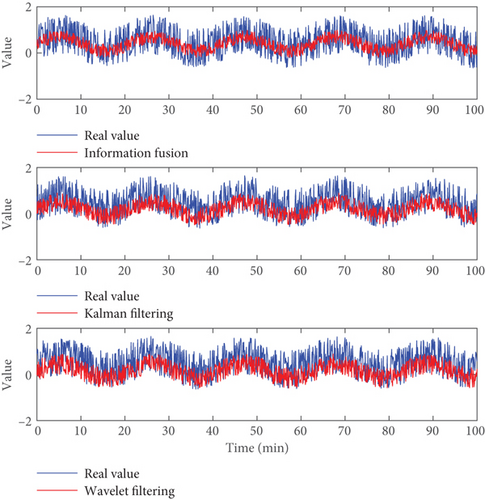
Figure 6 shows the computer simulation results of the above system. The dotted line in the figure is the positioning error under the condition of conventional Kalman filter. The solid line is the positioning error after using the joint Kalman filter technology. It can be seen that the accuracy of the fused system has been significantly improved. It shows that the proposed scheme is very effective in improving the accuracy and reliability of the whole system.
4.2. Convergence Verification of the Model
We apply the BP network in the neural network toolkit in MATLAB 2018b to realize the training algorithm. This toolbox contains many tool functions for BP network analysis and design. In this system, the forward network initialization function is mainly used: newff gives the initial threshold and weight of network training. The BP network is trained by the function: train, and the threshold and weight matrix of the trained BP neural network are obtained. Finally, the simulation function: Sim is used to simulate the trained network. At the same time, D-S evidence theory is applied to the BP neural network to prove the effectiveness of this method. We use the membership degree as the input of the BP neural network. The safety status of the disaster system is divided into four levels: safety S1, general state (S2), dangerous (S3), and relatively dangerous (S4). The safety status of the disaster system is coded as the following: S1 level: 0.1, 0.1, 0.1, 0.9; S2 grade: 0.1, 0.1, 0.9, 0.1; S3: 0.1, 0.9, 0.1, 0.1; and Grade S4: 0.9, 0.1, 0.1, 0.1. Since the data is designed when the disaster system is in the S1 state, the expected output of the neural network corresponding to the training samples is the following: design a BP neural network with 6 inputs and 4 outputs, using a three-layer neural network, with 6 inputs, 10 nodes in the negative layer, 4 nodes in the output layer, a learning rate of 0.01, a log sigmoid transfer function in the negative layer, and a purelin linear transfer function in the output layer. The expected error is 0.001, and the transfer function is trained by MATLAB software.
Collect 50 groups of sample data and 20 groups of test data; establish BP neural networks, CEF-BP, PSO-BP, and DSBP, namely, 3 evidence bodies E1, E2, and E3; train 50 groups of sample data and BP neural network; and then optimize them through the BP algorithm. The BP length is set to 5, the neural network error threshold is 0.05, and the probability distribution threshold is 0.8. When the BP neural network is optimized, input 20 groups of test data to the BP neural network for disaster diagnosis. The disaster prediction results of three BP neural networks corresponding to some test samples are obtained. Only from multiple BP neural networks, there will be uncertainty on the dial, and accurate diagnosis results cannot be obtained. When the results obtained from BP neural networks and DS evidence theory are fused, the accuracy of disaster prediction can be greatly improved (Figure 7).

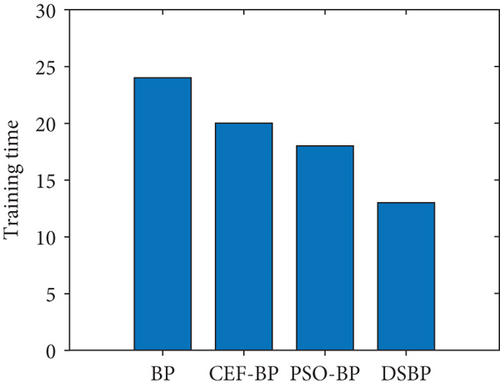
Bring the test data into the optimized neural network diagnosis model and the nonoptimized neural network diagnosis model, respectively. After 20 iterations of training, it can be found that the recognition ability of the optimized neural network to the data is much stronger than that of the nonoptimized neural network. Figure 8 shows the error curves of BP, CEF-BO, PSO-BP, and optimized DSBP neural network. After 15 operations, the nonoptimized BP neural network will not change the error value for 6 consecutive operations. At this time, the neural network training will automatically end. The validation sample error is 0.15 > 0.01, which cannot meet the set neural network prediction error requirements and cannot accurately diagnose disasters. The optimized DSBP neural network validation sample error can reach around 0.0021, which can meet the accuracy requirements of the neural network for disasters.
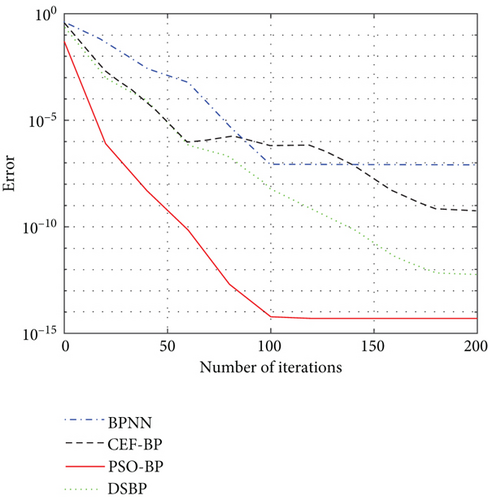
For such a complex problem, it is unrealistic to use a back propagation network (BP network) to store knowledge and judge the state with it in terms of learning speed and reasoning ability. When a single neural network (ANN) is used to judge the target state, it will inevitably lead to a large network structure and an increase in training samples, which makes it difficult for the network training to proceed smoothly. Because the network has poor robustness and is sensitive to sample error, it is easy to cause a series of problems such as low classification accuracy, long network training time, difficult network convergence, low diagnosis accuracy, and unreliable conclusions. Therefore, other models need to be explored. Combining the advantages of neural networks and D-S evidence theory, this paper proposes a multisensor data fusion algorithm based on the multineural network and D-S evidence theory. Firstly, the characteristic values of multiple sensor data are extracted by the wavelet analysis method, and then, the membership degree of each sensor signal and the coal mine safety state are obtained by the membership function method in fuzzy mathematics. Then, effective grouping is carried out, and a neural network is designed for each group of data. Secondly, the output of the neural network is normalized as the basic probability distribution function of D-S evidence theory; then, we use the fusion principle of D-S evidence theory to fuse multiple evidence spaces and finally draw a conclusion.
To verify the prediction accuracy of the algorithm, this paper compares the Mae index, max error index, and RMSE index. The performance index is shown in Figure 9, the distribution probability corresponding to the fused disaster category is greater than the threshold value 0.8, and the diagnosis results can be given immediately, and the diagnosis result is completely consistent with the actual disaster category. Therefore, the method in this paper obviously improves the deficiency of using only a single disaster prediction method and has a good fusion effect for the disaster prediction of uncertain results. Therefore, it has strong feasibility. According to the advantages and disadvantages of D-S evidence theory and BP neural network, the improved D-S evidence theory and BP neural network algorithm are introduced, and a fusion algorithm combining the two methods is proposed; that is, the advantages of the two methods are used, and the method of separating the evidence is used to solve the limitation of D-S evidence theory that requires the evidence to be relatively independent, and the problem of insufficient accuracy of the neural network due to large data volume is solved. This method effectively improves the accuracy of underground safety state judgment.
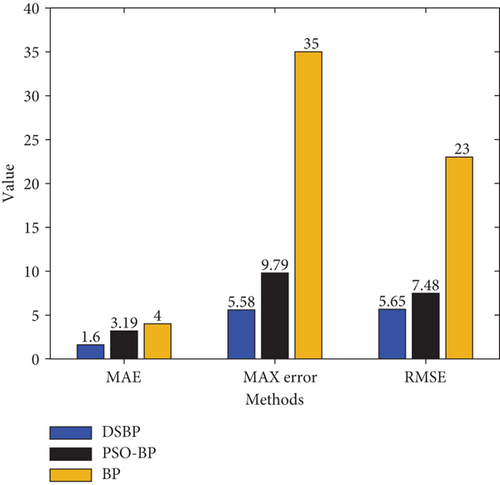
5. Conclusion
Due to the frequency and high risk of natural disasters, it is very necessary to study the disaster early warning system. In the 5G era, everything is interconnected, which is also an era when the application of big data cloud computing is more mature. When the new monitoring means are applied to the disaster early warning system, we will be more familiar with the disaster situation. For a common disaster, we can find and predict it earlier. The application of new technology will better ensure the operation of the disaster prevention system. This paper is aimed at making a coordinated disaster early warning system as comprehensive as possible, which can not only make an effective early warning of disasters through data collaboration but also play a good supporting role in the emergency response after disasters and give full play to the synergy of the platform. According to the comparison of different fusion levels of multisensor data fusion technology, it is determined to adopt decision-making level fusion to fuse all kinds of sensor data collected in the coal mine and judge the disaster state. We introduce the improved D-S evidence theory and BP neural network algorithm and use the two methods together, that is, a two-level fusion algorithm. The specific application process is to train the sensor signals by network, the calculated membership value is divided into two subneural networks for training, and the outputs of the two neural networks are normalized as the basic probability function of D-S evidence theory and then fused. By comparing and analyzing the fusion results, we can obtain more accurate results than using the two methods alone. At present, there is no mature theoretical guidance for the determination of the hidden layer of the BP neural network. At present, the approximate range is basically determined by an empirical formula, and then, the final number of hidden layers is determined by the trial and error method, which has certain randomness. Therefore, we need to return to the algorithm of the BP neural network and give a better solution to this problem through the study of the basic algorithm.
Conflicts of Interest
The authors declare that they have no known competing financial interests or personal relationships that could have appeared to influence the work reported in this paper.
Acknowledgments
This work was supported by the Sichuan Provincial Health and Health Commission Medical Research Project Fund: Research on the status of disaster preparedness and training effect of wheelchair users’ families based on the perspective of vulnerability (19PJ220).
Open Research
Data Availability
The data used to support the findings of this study are available from the corresponding author upon request.




